Eck Industries, an aluminum sand and permanent-mold foundry in Manitowoc, WI, has an exclusive license to commercialize a new cerium-aluminum (Ce-Al) alloy co-developed by the U.S. Dept. of Energy's Oak Ridge National Laboratory. The patent-pending alloy was developed by scientists at DOE's Critical Materials Institute (CMI), working with Eck Industries and researchers at DOE's Ames and Lawrence Livermore national labs to develop an alloy that is easy to work with, lightweight, corrosion-resistant, and “exceptionally stable at high temperatures.”
ORNL researchers led the development team while focusing on casting and microstructure property stability. Ames ran experiments on thermo-mechanical processing and examined the thermo-physical properties of the Ce-Al alloy. Lawrence Livermore performed characterization work using advanced microscopy and other methods. Eck was involved in pilot-scale experiments and provided manufacturing insight and expertise.
The resulting Ce-Al material is described as “ideal for creating lightweight, strong components for advanced automotive vehicles, aircraft, and power-generation systems, among others.
Cerium is a soft, ductile material and reportedly the most abundant rare-earth element. According to ORNL, cerium is widely available and inexpensive, and creating new uses for cerium supports domestic rare-earth mining operations and provides an innovative resource material to U.S. manufacturers.
ORNL stated that testing has shown its new Ce-Al alloy is stable at 500°C. So, for example, the temperature resistance means that automotive engines made using the new alloy can endure higher temperatures and achieve more complete fuel combustion, while weighing less. These are, of course, contributing factors to better fuel efficiency.
Orlando Rios, an ORNL researcher, noted that the Ce-Al alloy requires no additional thermal processing during or following casting. Casting the alloy can be done according to standard aluminum foundry practices, and without a protective atmosphere. "The alloy is thermodynamically stable," Rios said.
Beyond that, the cost of heat treatment and the additional machining required due to thermal distortion can be 50-60% of what is assumed for alloys used in comparable applications, and so energy costs could potentially be reduced by 30-60%, Rios noted. He said that because their heat-treatment and age-hardening steps are unnecessary for the Ce-Al alloy, it might significantly improve manufacturing competitiveness.
"The breakthrough properties observed in this innovative alloy will enable greater manufacturing energy efficiency and new energy-efficient products," according to Alan Liby, director of ORNL's Advanced Manufacturing Program.
"There has been tremendous interest from industry due to the unique material properties and low cost of this alloy," stated David Weiss, vice president of Engineering/R&D at Eck. "This project is a template for rapid development and commercialization. Not only did we bridge the research 'valley of death,' we also developed a highway for communication from our customers to us to help guide the project."









